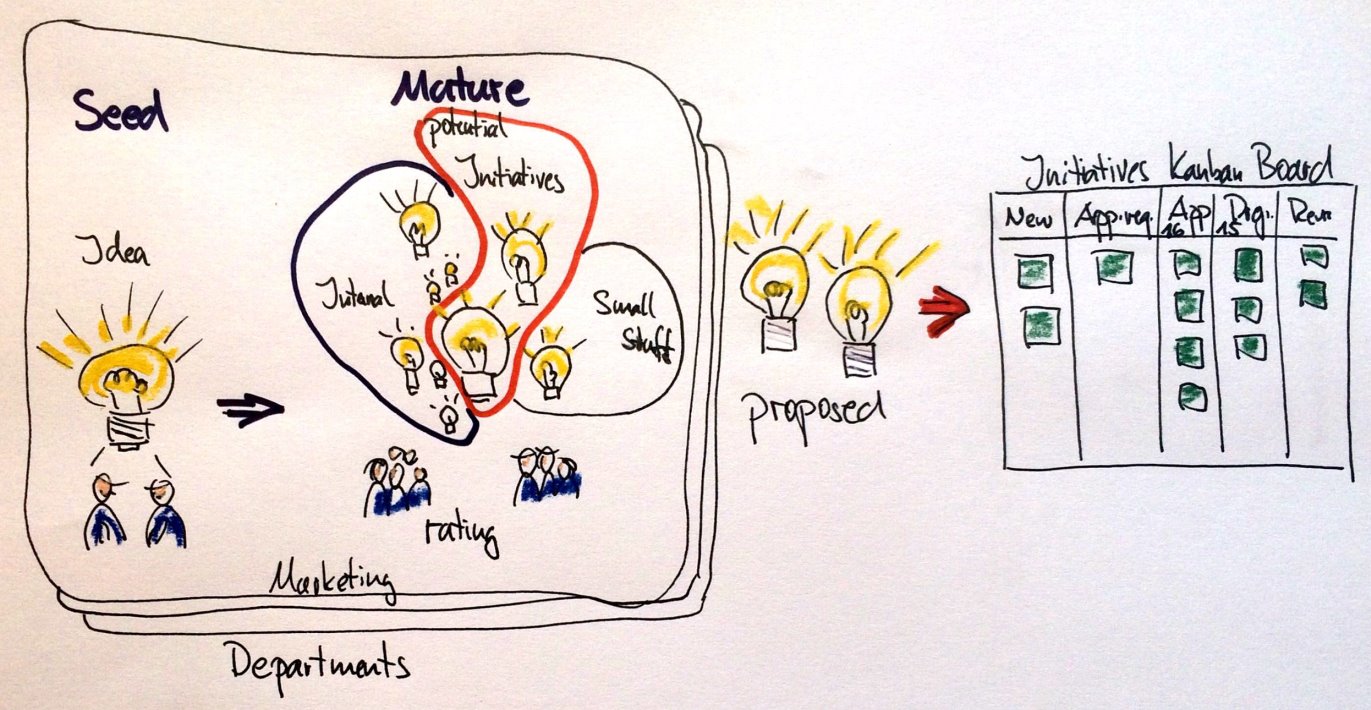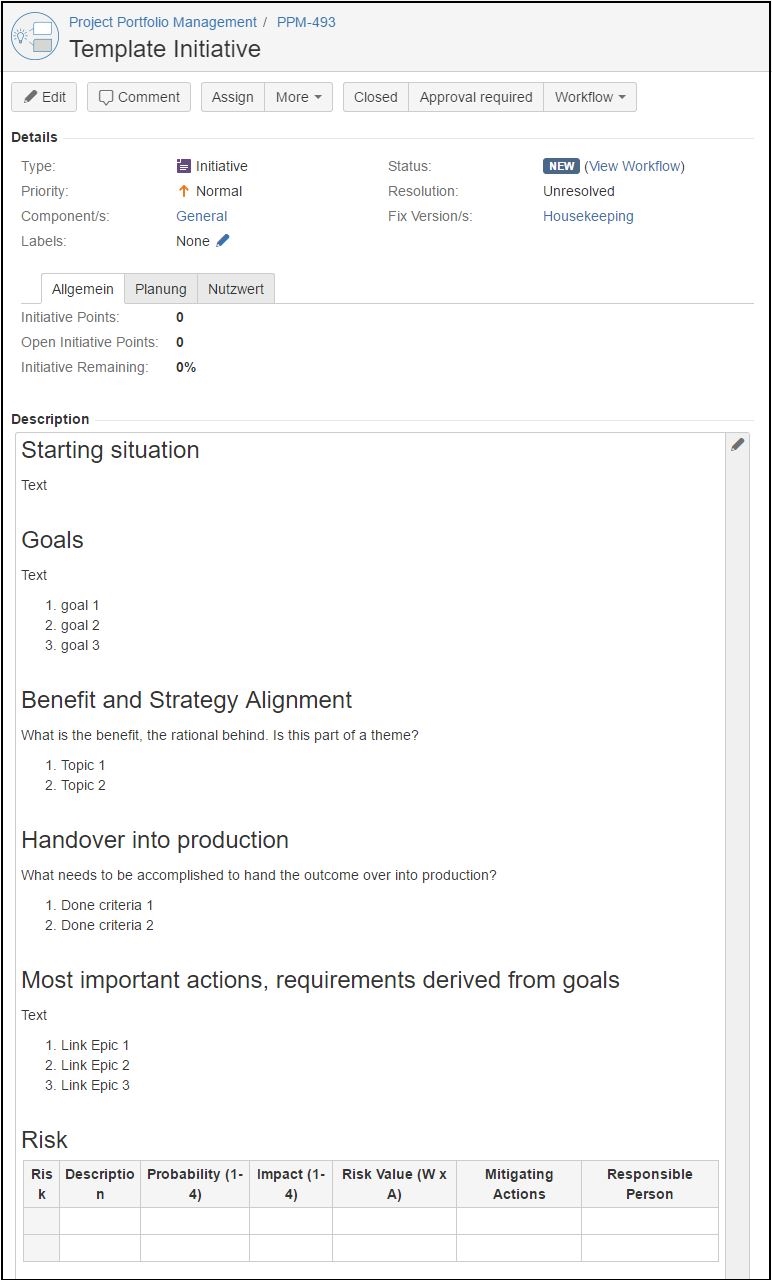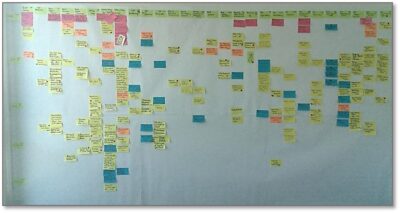Lean PPM step 4: The life cycle of an initiative
In my last blog I introduced you to the roadmap as seeding mechanism for our portfolio management. In this blog I want to explain how the initiatives are derived and managed in our Atlassian Jira system.
As you might imagine, at any time there are initiatives on different maturity level. Maturity spans from very vague und unclear ideas to well know initiatives with clear defined goals. Initiatives below a certain maturity level we call ideas. Ideas often are specified by a few phrases about what the outcome and the benefit for our customers and/or us might be. Ideas are the start of the value stream related with initiatives.
Ideas at Digitec / Galaxus basically are born at two different places in our organization. One place is a department like marketing, supply chain management, retail or engineering. The other place is the executive team.
The challenge is to create a Kanban system with simple and understood communication channels that route the ideas well prioritized through their life cycle. Quite a number of our ideas end up in our icebox, the icebox (actual the “on Hold” status in our Kanban system) holds potential initiatives for unfreezing any time in the future. The very creative teams in your company always generate many more ideas as can be realized with limited resources. Important is to communicate this aligned to our strategy and to make it transparent and understood.
Many ideas are tiny things a department can realize on its own. These ideas directly are handled by the department. This is part of the daily work of an department.
Many ideas do have the character of small enhancements that require limited engineering resources to be implemented. These ideas we run through a fastlane mechanism I will talk about in detail later. So far it is only of interest that the fastlane mechanism is a specific very lightweight input queue of low bureaucracy to engineering.
Only very few ideas are potential initiatives. These are the ones that span over departments, are more complicated and/or require a certain extend of resources to be realized. These ideas we mature towards initiatives that we run through our company wide initiative Kanban system. To manage this stage in the life cycle of an initiative – from first idea status to the “pretty sure that this is a real initiative” status, we introduced a lightweight innovation process in the departments. I will talk about that in as well in a future post, but actually this innovation process is following the “Stars to Road” concept of idea maturity. This stage in the life cycle of an initiative looks as following:

Schema of the Digitec Innovation Prozess
Formally we identified a well-defined set of states in the life cycle of an initiative from idea to closure. States of an initiative while living in the innovation process in the context of a department are:As you see, actually we established two processes in our organization that work hand in hand. The innovation process that generates ideas and develop potential initiatives towards the company wide initiative Kanban board; and as the second stage in the life cycle of an initiative the portfolio process that matures and drives an initiative from proposal to closure.
- Initiative idea new: An idea comes into existence
- Initiative idea approval required: The idea is proposed to the company wide initiative Kanban board
- Initiative idea approved: The idea is accepted by the innovation board that manages the company wide initiative Kanban board
In Jira we implemented initiatives living in the innovation process as issues of a new created issue type idea. Every department works with its own Kanban board for ideas. The Kanban board exists as a real physical white board working with sticky notes. Additionally every department owns a Kanban board in Jira managing ideas and normal tasks. The physical white boards are used as communication and collaboration medium. The Jira Kanban board holds a subset of the white board “cards”.
An initiative in the status “Initiative idea approved” will be moved from the department (Kanban board) to the company wide initiative Kanban board. In Jira this is a move of an idea issue from the department board into the company wide initiative Kanban board . With this step the department has to write a vision what the outcome of the initiative most probably shall be. The vision is a much focused description that shall not exceed two screen pages. In our tool setup an initiative is a Jira issue of type “initiative” (we created as well this issue type). The vision is stored in the description attribute of the issue and follows a template structure as following:

Description structure of an initiative in Atlassian Jira
This template guides a department to write a focused vision statement. On request a department gets support from the business development team in writing the vision statement.
States of an initiative while living in the portfolio process in the context of the company wide initiative Kanban board are:
- Initiative new: the executive team proposes a new initiative. This is the input channel for the executive committee into the company wide initiative Kanban board.
- Initiative approval required: the innovation board (this is our decision panel about initiatives) decides about initiatives in this status. The result is that the proposal is either approved, declined or set to on hold (stored in our initiatives icebox)
- Initiative approved: the innovation board accepted the initiative. In this status we invest more effort to develop the initiative (kind of backlog refinement) so it can be realized.
- Initiative on hold: the innovation board accepted the initiative. Nevertheless because of strategic reasons the innovation board decided not to invest effort now. The initiative is iceboxed. This status represents the icebox status of good ideas. The innovation board justifies why the initiative is iceboxed and gives feedback back to the source department
- Initiative declined: the innovation board decided that this proposal is never ever of any value. The innovation board justifies why and gives feedback back to the source department.
- Initiative in Process: we work on the initiative with the goal to create the outcome as fast as possible.
- Initiative in Review: the outcome is realized. Now we review the outcome with all stakeholders before we move the responsibility to work with the results back into the departments.
- Initiative closed: All stakeholders agree that the outcome is satisfying.
Our company wide initiative Kanban board acts as following:

The life cycle of items through the Digitec Galaxus innovation and portfolio processes
Jira experts will encounter that such a board cannot be implemented as a single Kanban board in Jira. Actually our implementation offers two views. The first view implements the lower swimlane for evaluating a deciding about ideas, the second view implements the upper swimlane used in the portfolio management of initiatives.
Another challenging task in portfolio management is the demand – capacity balance. A lean portfolio management system is built on a pull system instead of a push system. Teams working with the Kanban system pull work as represented and prioritized on the Kanban boards. Once priority is defined, the speed items develop to the next status and finally to done depends on the resources made available. The goal of a lean portfolio management is to create the maximum outcome with a given capacity. What “given capacity” is depends on the investment management is willing to invest.
The demand is represented by the initiatives in our Kanban system. The capacity is limited by our workforce in the departments and engineering. One key resource and always a bottleneck for sure are our engineering resources, i.e. our software development department including business analysts, software engineers, business intelligence experts and (yes you may wonder, but I discuss this later on) project managers. The reason is obvious: we always have more ideas what we could realize compared to the affordable resources.
Well – I will talk about our ideas of demand – capacity balance in an upcoming blog (I see there are some upcoming blogs I have to write J). As well prioritization of initiatives is a very interesting topic I will address any time in the future. So stay tuned.



